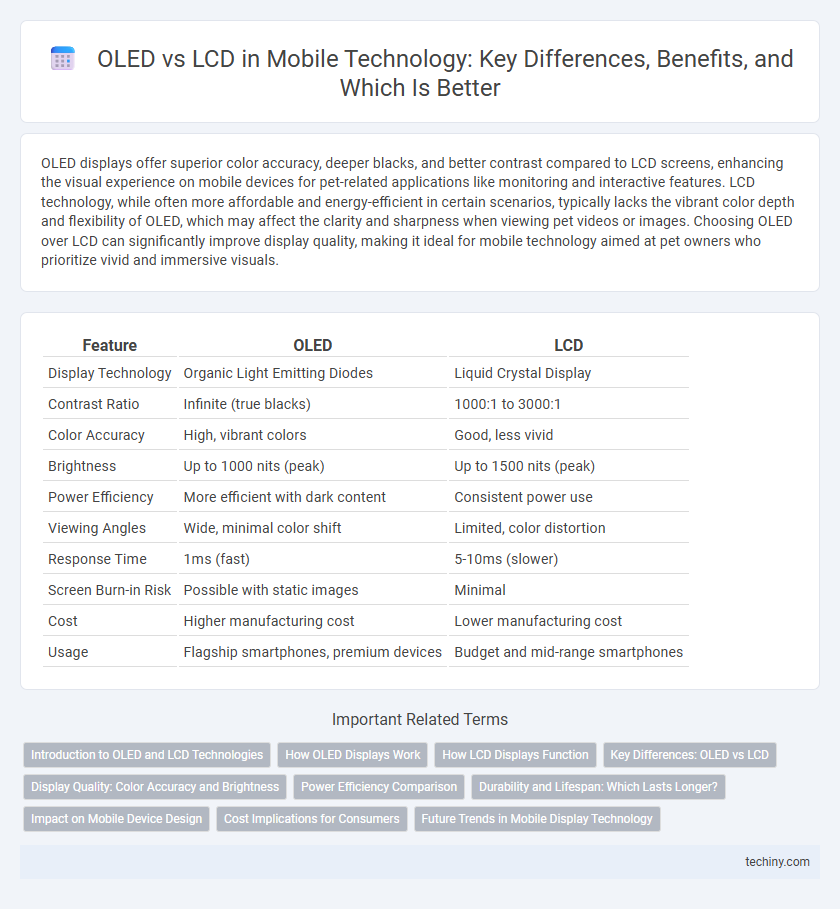OLED displays offer superior color accuracy, deeper blacks, and better contrast compared to LCD screens, enhancing the visual experience on mobile devices for pet-related applications like monitoring and interactive features. LCD technology, while often more affordable and energy-efficient in certain scenarios, typically lacks the vibrant color depth and flexibility of OLED, which may affect the clarity and sharpness when viewing pet videos or images. Choosing OLED over LCD can significantly improve display quality, making it ideal for mobile technology aimed at pet owners who prioritize vivid and immersive visuals.
Table of Comparison
| Feature | OLED | LCD |
|---|---|---|
| Display Technology | Organic Light Emitting Diodes | Liquid Crystal Display |
| Contrast Ratio | Infinite (true blacks) | 1000:1 to 3000:1 |
| Color Accuracy | High, vibrant colors | Good, less vivid |
| Brightness | Up to 1000 nits (peak) | Up to 1500 nits (peak) |
| Power Efficiency | More efficient with dark content | Consistent power use |
| Viewing Angles | Wide, minimal color shift | Limited, color distortion |
| Response Time | 1ms (fast) | 5-10ms (slower) |
| Screen Burn-in Risk | Possible with static images | Minimal |
| Cost | Higher manufacturing cost | Lower manufacturing cost |
| Usage | Flagship smartphones, premium devices | Budget and mid-range smartphones |
Introduction to OLED and LCD Technologies
OLED (Organic Light Emitting Diode) technology utilizes organic compounds that emit light in response to electric current, enabling thinner displays with higher contrast ratios and more vibrant colors compared to LCD (Liquid Crystal Display) technology. LCD screens rely on a backlight system and liquid crystals to modulate light, often resulting in less efficient power consumption and lower contrast levels. OLED's self-emissive nature allows for deeper blacks and wider viewing angles, making it a preferred choice for modern mobile devices seeking enhanced visual performance.
How OLED Displays Work
OLED displays operate by using organic compounds that emit light when an electric current passes through them, allowing each pixel to produce its own light independently. This self-emissive technology results in higher contrast ratios and deeper blacks compared to LCDs, which rely on backlighting. The ability of OLED panels to turn off individual pixels enhances energy efficiency and supports thinner, more flexible screen designs in mobile devices.
How LCD Displays Function
LCD displays function by using a backlight that shines through liquid crystal cells which manipulate light to produce images. Each pixel contains subpixels with color filters (red, green, and blue) that adjust light passage by changing the alignment of liquid crystals under an electric current. This technology enables energy-efficient displays with high brightness levels, commonly utilized in a range of mobile devices.
Key Differences: OLED vs LCD
OLED and LCD differ fundamentally in display technology, with OLEDs featuring self-emissive pixels that provide deeper blacks and higher contrast ratios, while LCDs rely on a backlight that limits black level accuracy. OLED screens offer faster response times and wider viewing angles compared to LCDs, making them ideal for dynamic content and mobile devices. Additionally, OLED displays typically consume less power when rendering darker images, contributing to enhanced battery efficiency in smartphones and tablets.
Display Quality: Color Accuracy and Brightness
OLED displays offer superior color accuracy with deeper blacks and more vibrant hues due to individual pixel illumination, enhancing contrast and visual clarity. LCD screens rely on backlighting, which can reduce contrast and produce less accurate colors, especially in dark scenes. OLED technology also delivers higher brightness levels and better viewing angles, making it the preferred choice for immersive mobile display experiences.
Power Efficiency Comparison
OLED displays consume significantly less power than LCDs when rendering dark or black content due to their emissive nature, where each pixel generates its own light and can be turned off individually. LCDs rely on a backlight that stays on regardless of the image, resulting in constant power consumption that is higher especially during darker scenes. This makes OLED technology more energy-efficient for mobile devices with predominantly dark-themed interfaces or apps, extending battery life compared to traditional LCD screens.
Durability and Lifespan: Which Lasts Longer?
OLED displays typically offer superior image quality but have shorter lifespans due to organic material degradation, with an average durability of around 30,000 to 50,000 hours. LCD screens, using inorganic crystals and backlighting, generally last longer, often exceeding 60,000 hours in lifespan, making them more durable under prolonged use. Environmental factors like screen burn-in affect OLED durability, whereas LCDs are more resistant to such wear, influencing the overall longevity of mobile displays.
Impact on Mobile Device Design
OLED displays offer flexible, thinner panels that enable sleeker mobile device designs and curved screens, while LCDs require thicker backlighting layers, limiting design versatility. The superior contrast ratio and deeper blacks of OLED technology improve visual quality without increasing device thickness, promoting more immersive user experiences. OLED energy efficiency directly impacts battery life, allowing manufacturers to optimize device size and weight for enhanced portability.
Cost Implications for Consumers
OLED displays typically have higher production costs than LCDs due to complex manufacturing processes and expensive materials. Consumers may see higher retail prices for smartphones and devices with OLED screens, although the technology offers superior color accuracy and energy efficiency. In contrast, LCD devices generally provide more budget-friendly options, appealing to price-sensitive buyers despite lower contrast ratios and less vibrant visuals.
Future Trends in Mobile Display Technology
OLED technology is increasingly favored in mobile displays for its superior color accuracy, deeper blacks, and energy efficiency compared to LCD. Emerging micro-LED displays promise even greater brightness and longevity, driving future innovations in screen technology. The trend towards foldable and flexible screens highlights a shift in mobile display design, enhancing user experience and device durability.
OLED vs LCD Infographic

 techiny.com
techiny.com